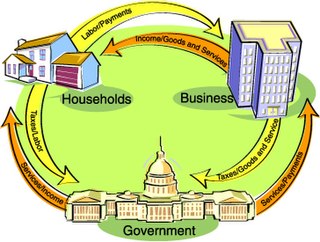Related Research Articles

Macroeconomics is a branch of economics dealing with performance, structure, behavior, and decision-making of an economy as a whole. For example, using interest rates, taxes, and government spending to regulate an economy’s growth and stability. This includes regional, national, and global economies. According to a 2018 assessment by economists Emi Nakamura and Jón Steinsson, economic "evidence regarding the consequences of different macroeconomic policies is still highly imperfect and open to serious criticism."

In economics, a recession is a business cycle contraction when there is a general decline in economic activity. Recessions generally occur when there is a widespread drop in spending. This may be triggered by various events, such as a financial crisis, an external trade shock, an adverse supply shock, the bursting of an economic bubble, or a large-scale anthropogenic or natural disaster. In the United States, it is defined as "a significant decline in economic activity spread across the market, lasting more than a few months, normally visible in real GDP, real income, employment, industrial production, and wholesale-retail sales". In the United Kingdom, it is defined as a negative economic growth for two consecutive quarters.

New Keynesian economics is a school of macroeconomics that strives to provide microeconomic foundations for Keynesian economics. It developed partly as a response to criticisms of Keynesian macroeconomics by adherents of new classical macroeconomics.

Business cycles are intervals of expansion followed by recession in economic activity. They have implications for the welfare of the broad population as well as for private institutions. Typically business cycles are measured by applying a band pass filter to a broad economic indicator such as Real Gross Domestic Production. Here important problems may arise with a commonly used filter called the "ideal filter". For instance if a series is a purely random process without any cycle, an "ideal" filter, better called a block filter, a spurious cycle is produced as output. Fortunately methods such as [Harvey and Trimbur, 2003, Review of Economics and Statistics] have been designed so that the band pass filter may be adapted to the time series at hand.
Economic data or economic statistics are data describing an actual economy, past or present. These are typically found in time-series form, that is, covering more than one time period or in cross-sectional data in one time period. Data may also be collected from surveys of for example individuals and firms or aggregated to sectors and industries of a single economy or for the international economy. A collection of such data in table form comprises a data set.
Economic forecasting is the process of making predictions about the economy. Forecasts can be carried out at a high level of aggregation—for example for GDP, inflation, unemployment or the fiscal deficit—or at a more disaggregated level, for specific sectors of the economy or even specific firms.Economic forecasting is a measure to find out the future prosperity of a pattern of investment and is the key activity in economic analysis. Many institutions engage in economic forecasting: national governments, banks and central banks, consultants and private sector entities such as think-tanks, companies and international organizations such as the International Monetary Fund, World Bank and the OECD. A broad range of forecasts are collected and compiled by "Consensus Economics". Some forecasts are produced annually, but many are updated more frequently.

National accounts or national account systems (NAS) are the implementation of complete and consistent accounting techniques for measuring the economic activity of a nation. These include detailed underlying measures that rely on double-entry accounting. By design, such accounting makes the totals on both sides of an account equal even though they each measure different characteristics, for example production and the income from it. As a method, the subject is termed national accounting or, more generally, social accounting. Stated otherwise, national accounts as systems may be distinguished from the economic data associated with those systems. While sharing many common principles with business accounting, national accounts are based on economic concepts. One conceptual construct for representing flows of all economic transactions that take place in an economy is a social accounting matrix with accounts in each respective row-column entry.
In economics, gross output (GO) is the measure of total economic activity in the production of new goods and services in an accounting period. It is a much broader measure of the economy than gross domestic product (GDP), which is limited mainly to final output. As of first-quarter 2019, the Bureau of Economic Analysis estimated gross output in the United States to be $37.2 trillion, compared to $21.1 trillion for GDP.
Dynamic stochastic general equilibrium modeling is a macroeconomic method which is often employed by monetary and fiscal authorities for policy analysis, explaining historical time-series data, as well as future forecasting purposes. DSGE econometric modeling applies general equilibrium theory and microeconomic principles in a tractable manner to postulate economic phenomena, such as economic growth and business cycles, as well as policy effects and market shocks.
The Survey of Professional Forecasters (SPF) is a quarterly survey of macroeconomic forecasts for the economy of the United States issued by the Federal Reserve Bank of Philadelphia. It is the oldest such survey in the United States.
The Supervisory Capital Assessment Program, publicly described as the bank stress tests, was an assessment of capital conducted by the Federal Reserve System and thrift supervisors to determine if the largest U.S. financial organizations had sufficient capital buffers to withstand the recession and the financial market turmoil. The test used two macroeconomic scenarios, one based on baseline conditions and the other with more pessimistic expectations, to plot a 'What If?' exploration into the banking situation in the rest of 2009 and into 2010. The capital levels at 19 institutions were assessed based on their Tier 1 common capital, although it was originally thought that regulators would use tangible common equity as the yardstick. The results of the tests were released on May 7, 2009, at 5pm EST.

Macroeconomic theory has its origins in the study of business cycles and monetary theory. In general, early theorists believed monetary factors could not affect real factors such as real output. John Maynard Keynes attacked some of these "classical" theories and produced a general theory that described the whole economy in terms of aggregates rather than individual, microeconomic parts. Attempting to explain unemployment and recessions, he noticed the tendency for people and businesses to hoard cash and avoid investment during a recession. He argued that this invalidated the assumptions of classical economists who thought that markets always clear, leaving no surplus of goods and no willing labor left idle.
Nowcasting in economics is the prediction of the present, the very near future, and the very recent past state of an economic indicator. The term is a contraction of "now" and "forecasting" and originates in meteorology. It has recently become popular in economics as typical measures used to assess the state of an economy, are only determined after a long delay and are subject to revision. Nowcasting models have been applied most notably in Central Banks, who use the estimates to monitor the state of the economy in real-time as a proxy for official measures.
Consensus Economics is a global macroeconomic survey firm that polls more than 700 economists monthly for their forecasts for over 2000 macroeconomic indicators in 115 countries. The company is headquartered in London, United Kingdom.
Economic Outlook is a twice-yearly analysis published by the Organisation for Economic Co-operation and Development (OECD) with economic analysis and forecasts for future economic performance of OECD countries. The main version is in English, and it is also published in French and German. The OECD also publishes Monthly Economic Indicators to complement the twice-yearly Economic Outlook.
OECD Main Economic Indicators, often simply called Main Economic Indicators and abbreviated MEI, is a monthly publication by the Organisation for Economic Co-operation and Development (OECD) of economic indicators worldwide. According to the official website, it "presents comparative statistics that provide an overview of recent international economic developments." The publication is available online at the OECD iLibrary.
The Livingston Survey is a biannual survey about the economy of the United States conducted by the Federal Reserve Bank of Philadelphia. Begun in 1946, it is the longest continuous record of economists' expectations.
The Greenbook of the Federal Reserve Board of Governors is a book with projections of various economic indicators for the economy of the United States produced by the Federal Reserve Board before each meeting of the Federal Open Market Committee. The projections are referred to as Greenbook projections or Greenbook forecasts. Many of the variables projected coincide with variables covered in the Survey of Professional Forecasters.
The Wall Street Journal Economic Survey, also known as the Wall Street Journal Economic Forecasting Survey, could refer to either the monthly or the semi-annual survey conducted by the Wall Street Journal of over 50 economists on important indicators of the economy of the United States.
The Asian Development Outlook is an annual publication produced by the Asian Development Bank (ADB). It offers economic analysis and forecasts, as well as an examination of social development issues, for most countries in Asia. It is published each March/April with an update published in September and brief supplements published in July and December. The publication is prepared by staff of ADB's regional departments, and field offices, under the coordination of the Economic Research and Regional Cooperation Department with the goal of developing "consistent forecasts for the region".
References
- 1 2 3 4 Moore, Randell E. "Blue Chip Economic Indicators" . Retrieved April 13, 2014.
- ↑ "Blue Chip Financial Forecasts". Blue Chip Publications, Aspen Publishers . Retrieved April 13, 2014.
- ↑ Swidler, Steve; Ketcher, David (February 1990). "Economic Forecasts, Rationality, and the Processing of New Information over Time". Journal of Money, Credit, and Banking . 22 (1): 65–76. doi:10.2307/1992128. JSTOR 1992128.
- ↑ Batchelor, Roy; Dua, Pami (November 1991). "Blue Chip Rationality Tests". Journal of Money, Credit, and Banking . 23 (4): 692–705. doi:10.2307/1992704. JSTOR 1992704.
- ↑ Laster, David; Bennett, Paul; Geoum, In Sun (1999). "Rational Bias in Macroeconomic Forecasts". The Quarterly Journal of Economics . 114 (1): 293–318. CiteSeerX 10.1.1.201.35 . doi:10.1162/003355399555918.
- ↑ Elmendorf, Douglas William (March 27, 2013). "How Different Future Interest Rates Would Affect Budget Deficits". Congressional Budget Office . Retrieved April 13, 2014.
- ↑ Conerly, Bill (September 2, 2013). "Economic Assumptions For Your 2014 Business Plan". Forbes . Retrieved April 21, 2014.
- ↑ Epstein, Gene (June 23, 2012). "The Chips Are a Mixed Bag: Blue Chip Economic Indicators puts its consensus odds of a recession over the next year at nearly one in four -- but it may be overemphasizing a soft patch". Barron's . Retrieved April 13, 2014.
- ↑ Barbera, Robert; Wright, Jonathan (March 2, 2014). "A Consistent Set of Interest Rate and Real Growth Assumptions Suggests Stable Debt to GDP Ratios in the Out years". Center for Financial Economics, Johns Hopkins University. Archived from the original on April 15, 2014. Retrieved April 13, 2014.
- ↑ Romer, Christina (March 15, 2009). "Last week the Blue Chip Economic Indicators came out that surveys lots of private forecasters. Almost all of them are predicting a turnaround in the third quarter and positive growth in the fourth quarter". PolitiFact . Retrieved April 13, 2014.